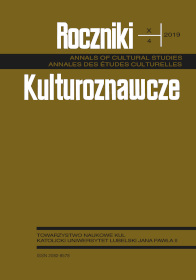Wystraszyć i rozbawić: Mediatyzacja emocji w headach radiowych serwisów informacyjnych
Abstrakt
Informacja radiowa, ze swej natury obiektywna, niesie za sobą często ogromny ładunek emocjonalny. Nadawcy, chcąc zatrzymać słuchacza, odwołują się do skrajnych emocji: na jednym biegunie za cel stawiają sobie wywołanie poczucia zaniepokojenia, na drugim próbują rozbawić odbiorcę lub dostarczyć mu rozrywki. Media bombardują doniesieniami dotyczącymi terroru, krwawych wypadków, sporów politycznych czy katastrof ekologicznych. Aby rozładować to napięcie, nadawcy sięgają po infotainment, informacje lekkie, zabawne, czasami wręcz infantylne. Najsilniej nacechowane emocjonalnie są heady zapowiadające serwisy informacyjne. I to właśnie te elementy serwisów informacyjnych Radia ZET z okresu od 6 do 12 maja 2019 r. stanowią materiał do analizy. Badania ilościowe pokazują, po które emocje nadawcy sięgają najczęściej, natomiast analiza jakościowa pozwoli przyjrzeć się środkom językowym wykorzystywanym do tego celu.
Bibliografia
Bauer, Zbigniew. „Gatunki dziennikarskie”. W: Dziennikarstwo i świat mediów, red. Zbigniew Bauer & Edward Chudziński, 143–173. Kraków: Universitas, 2000.
Chyliński, Marek, & Stephan Russ-Mohl. Dziennikarstwo. Warszawa: Grupa Wydawnicza Polskapresse, 2008.
Dobek-Ostrowska, Bogusława. Podstawy komunikowania społecznego. Wrocław: Astrum, 1999.
Gerring, Richard J., & Philip G. Zimbardo. Psychologia i życie. Przełożyli Józef Radzicki, Ewa Czerniawska i in., Warszawa: Wydawnictwo Naukowe PWN, 2011.
Hasła: „tragiczny”, „protest”. Słownik języka polskiego PWN. Dostęp 29.03.2020. https://sjp.pwn.pl/szukaj/tragiczny, https://sjp.pwn.pl/slowniki/protest.
Inny słownik języka polskiego PWN, red. Mirosław Bańko. Warszawa: Wydawnictwo Naukowe PWN, 2000.
Kaszewski, Krzysztof. Media o sobie. Językowe elementy autopromocyjne w przekazach informacyjnych prasy, radia i telewizji. Warszawa: Wydawnictwo Naukowe Semper, 2018.
Kępa-Figura, Danuta. „Gry językowe we współczesnej komunikacji medialnej — semantyczna i pragmatyczna analiza języka mediów”. Prace Językoznawcze 11 (2009): 95–113.
Kurdupski, Michał. „Radio ZET i Trójka z największymi spadkami, RMF FM liderem słuchalności”. Wirtualnemedia. Dostęp 29.03.2020. https://www.wirtualnemedia.pl/artykul/radio-wyniki-sluchalnosci-marzec-maj-2019-rmf-fm-liderem.
Michalczyk, Stanisław. „Kognicje i emocje w procesie recepcji mediów”. Rocznik Prasoznawczy 11 (2017): 11-31.
Szewczuk, Włodzimierz. Encyklopedia psychologii. Warszawa: Fundacja Innowacja, 1998.
Wojtak, Maria. Gatunki prasowe. Lublin: Wydawnictwo Uniwersytetu Marii Curie-Skłodowskiej, 2004.
Żydek-Bednarczuk, Urszula. Wprowadzenie do lingwistycznej analizy tekstu. Kraków: Universitas, 2005.





